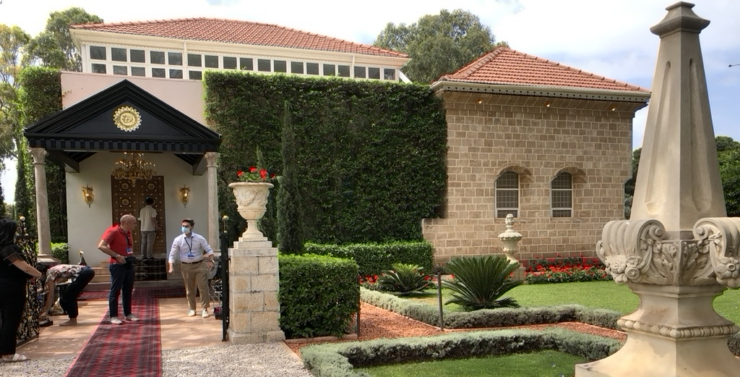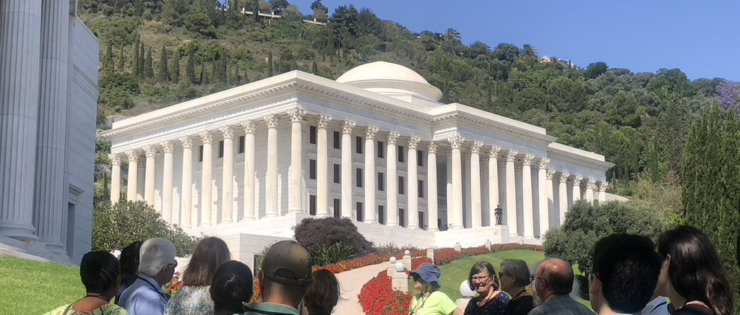From May 21st to May 31st, 2022, I was a participant-researcher in a Bahá’i pilgrimage to the world center of the Bahá’i religioni with the aim to write an ethnographic study of the core ritual of the Bahá’i faith community. Bahá’u’llah, the founder and prophet, announced in 1863 his claim to a revelation of God. The religion began in 19th-century Persia as a movement within shi’a islam. Not as a new religion, but intended as a continuation of all other religions that are, according to the founder, originally one. Central to the revelation of Bahá’u’lláh is the call to unity: unity of God, unity of religion, unity of humanity. De Bahá’is describe their religion as on independent world religion. Today around 7 million Bahá’is are worldwide registered in 180 countries.
The world center, where the pilgrimage toke place, is an impressive location in Haifa, Israël, where it was developed on Mount Carmel. During his exile Bahá’u’llah was prisoned by the Ottoman sultan and sent to the Palestinian port city of Akká. During his visit to Mount Carmel in 1891, Bahá’u’lláh stood near a circle of cypress trees and showed Abdu’l-Bahá, his son, where the tomb of the Báb, the herald-prophet, should be built.

Abdu’l-Bahá underlines this choice by describing Israël as the “Most Holy Land”, and as the “Nest of the Prophets”. Whitin the “holy land” the mountain Carmel rises as the “mountain of God” of immemorial sanctity, the “Vineyard of the Lord, the “Retrait of Elijah, which must be regarded as the center of the world and the Qiblih of the nations.

The pilgrimage lasts ten days, and takes participants to the locations where the Holy Family stayed in Haifa and Akká. The tour includes listening to stories and lectures about the faith, celebrating the holy days, visiting the shrines, gardens and buildings of the world center, meeting the religious participants and those responsible in the world center. The emphasis during the pilgrimage is on meeting the “Two Divine Messengers” that, it is claimed, stay in the shrine of the Báb in Haifa and the shrine of Bahá’u’lláh in Akká.

I have experienced the ten-day pilgrimage as a meticulously orchestrated and executed journey, down to the last detail. As a participant and researcher, I was able to observe, question, experience and reflect. I described the pilgrimage as a day after day ethnographic story and documented it with photographs. The pilgrimage took place in the aesthetically almost perfect creation of the Bahá’i world centre – the shrines, the gardens, the buildings and structures. Above the beautiful gardens around the shrine of the Báb dominates the Universal
House of Justice on the Arc. For the Bahá’is the architecture of the building expresses the importance of their religion for the future of humanity.

In the analysis I argued that the Bahá’i pilgrimage is a journey designed, under auspices of the Universal House of Justice, close to perfection by deploying a wide range of sensational forms that are intended to elicit emotional responses through stimulating the senses.

The pious pilgrims are to be immersed, metaphorically speaking, in the culture of the Bahá’i community. Being together (communitas), far from the daily hassles, in a shared mood of awe and adoration for the Bahá’i spiritual leaders, the pilgrims respond to the magnificence with a “wow”-reaction of which “awe” constitutes a large part. Other than the tourist, who also has a “wow”-reaction when visiting the site, the pilgrims’ responses have been profoundly prepared by their personal and collective history of self-persuasion. Their inner conviction which was already present prior to the pilgrimage directs their perception and their “wow” reaction, which in turn reinforces their commitment to the faith, the religious leaders and the worldwide Bahá’i religious community.

In conclusion, the productive and receptive parts of the Bahá’i pilgrimage fit like key-hole and key as long as the pilgrim is not plagued by doubts that do not yield to the doctrine of the Bahá’i Faith. The devotees express their adoration of the spiritual leaders of the Bahá’i Faith. The pilgrimage is for them the outer manifestation of the inner journey of their beliefs. It feels for them as coming home. The research provides insight into how the pilgrimage, by using a wide range of sensational forms, leads to an experience that confirms the pilgrims’ religious beliefs and their connection with the Bahá’í community.
i You can read the full study, under the supervision of Birgit Meyer, thesis UU master’s program “Religion and Society”, Islam track. De meest heilige plaats op aarde.pdf (50.28Mb)
Wilfried Claus, 1954, studied Psychological and Educational Sciences at the Catholic University of Leuven. Half of his professional career he worked as a strategy management consultant, continued by senior management positions for high tech international companies and change management interim positions for societal organizations. The impact of religion, on individuals, their communities and the society, was always subject of his curiosity, which finally ended up in following the master program “Religion and Society’, track Islam, at the University of Utrecht. The announced last Abrahamic religion, founded by Bahá’u’llah in 1863, got his interest leading to four papers and a master thesis on the Bahá’i Faith. In November 2023 he got a master in “Religious Science” with honors.
